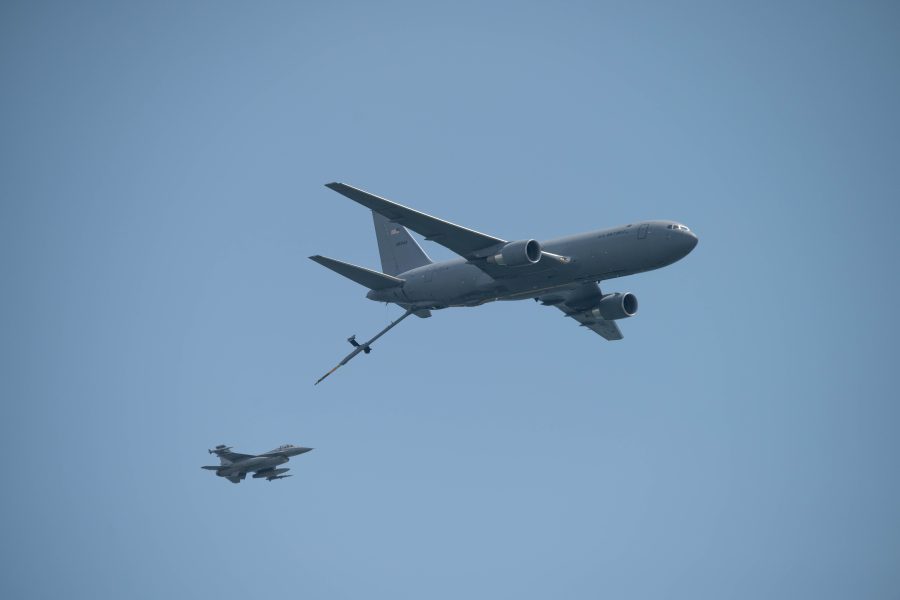A trio of refueling accidents since October 2022 were caused by fighter jets’ inability to disconnect after taking on fuel from the KC-46 refueler’s boom, Air Mobility Command revealed Aug. 25. The Air Force said it is working with the tanker’s maker, Boeing, on a fix.
In three separate accident investigation board reports, officials described a similar series of events playing out Oct. 15, 2022; Nov. 7, 2022; and Aug. 21, 2024.
In each case, the KC-46 was refueling fighter aircraft when the boom’s nozzle became “bound,” or stuck, in the receiving aircraft’s refueling receptacle due to high radial forces. Each incident triggered breakaway procedures, with varying results:
- In October 2022, the KC-46’s boom flew up and struck the tanker’s tail, damaging the boom, tail, and auxiliary power unit structures. Damages were estimated at $8.3 million.
- In November 2022, the boom’s nozzle broke, with damages limited to an estimated $103,000.
- In August 2024, the boom flew up and struck the tanker’s tail with such violence that the boom broke, with pieces falling to the ground. The tail section was also damaged, including parts related to the auxiliary power unit. The total estimated damage: $14.4 million.
The 2022 mishaps both involved KC-46s from 305th Air Mobility Wing out of Joint Base McGuire-Dix-Lakehurst, N.J., while the 2024 mishap involved a Pegasus assigned to the 22nd Air Refueling Wing from McConnell Air Force Base, Kan. In the first and third incidents, the receiving aircraft was an F-15E Strike Eagle. In the second, it was an F-22 raptor.
In both the 2022 incidents, investigators cited “known limitations” in the boom’s control system and determined that inadvertent inputs by the boom operators caused the nozzles to become bound. The KC-46 has an open deficiency report related to its flight control stick, which flies the boom, both reports state: The stick is “extremely sensitive and [boom operators] can inadvertently make inputs into the FCS while in contact.”
Both reports also noted another relevant KC-46 deficiency—the boom’s Remote Vision System display, which shows a “HI LOAD” warning when radial forces exceed the nozzle’s limits. Testers have said the warning is ineffective, the reports state, “due to ‘lack of contrast’ and its placement ‘outside the [boom operator’s] direct field of view.’”
The 2024 incident was more complex. Investigators determined the boom operator attempted to make a connection outside the refueling envelope; breakaway procedures were not completely followed; and the boom operator did not understand the boom flight control logic, meaning his flight control stick inputs “were out of sync with the physical flight controls.”
In all three cases, investigators noted that the receiver aircraft was flying too fast compared to the tanker, creating radial forces on the boom. The fighter pilots also all failed to consider the known and unresolved “stiff boom” deficiency on the KC-46.
Different actions by the boom operators resulted in vastly different outcomes.
In the November 2022 mishap, for example, accident investigation board president Col. Justin Ballinger noted that the boom operator brought the flight controls on the boom back to neutral after the breakaway command, which “reduced the binding and allowed for the physical separation of [the aircraft] and averted what could have been a much more serious and damaging accident.”
In the more damaging mishaps, investigators said the boom operators did not heed a directive to avoid “abrupt” flight control inputs if a bound nozzle is suspected. As a result, in both cases. once the boom became unbound, it flew wildly and struck the KC-46.
Yet the reports also noted broader problems in teaching boom operators to handle the KC-46. The October 2022 report, for example, states that “the command guidance and training for inadvertent FCS inputs, radial boom forces, and nozzle binding was incomplete and in one case, contradictory.” The November 2022 report cites “training and guidance limitations.” And the August 2024 report says that “there is minimal discussion, if any, of the boom logic functions” in KC-46 manuals and training materials.
Two of the reports also note that KC-46 Boom Operator Trainer simulator “cannot recreate nozzle binding … preventing aircrew from being able to replicate real-world situations.”
In a release announcing all three reports, Air Mobility Command deputy boss Lt. Gen. Rebecca Sonkiss defended the embattled KC-46.
“The KC-46 tanker fleet will sustain our air refueling mission capabilities for decades to come,” said Sonkiss. “Challenges with adding a new aircraft to the fleet are not uncommon but we do not take these incidents lightly. We have used the lessons learned to refine our KC-46 operations, including focused training and guidance while partnering with the contractor to implement long-term solutions.”
Those refinements include specified training for refueling fighter aircraft and increasing the refueling envelope from six to 10 feet, giving operators more time to react, AMC noted in its release.
Yet the issue is far from settled. In July, a KC-46 tanker suffered damage to its boom while refueling F-22 Raptors off the coast of Virginia. AMC confirmed in its release that the incident once again involved nozzle binding, though the exact causes remain under investigation.
Meanwhile, the Air Force and Boeing are working on multiple fixes to the KC-46 and its boom. These include a Boom Telescope Actuator Redesign and a new Remote Vision System. Both are expected to continue into fiscal 2027, according to documents.
Issues with the refueling system led the Air Force to put restrictions on the tanker that it then gradually lifted as Airmen developed workarounds and new procedures. It is not yet cleared for operational taskings worldwide, with the exception of the A-10 Warthog.
The service announced plans earlier this year to buy up to 75 more KC-46s to replace aging KC-135s, forgoing a competition.


